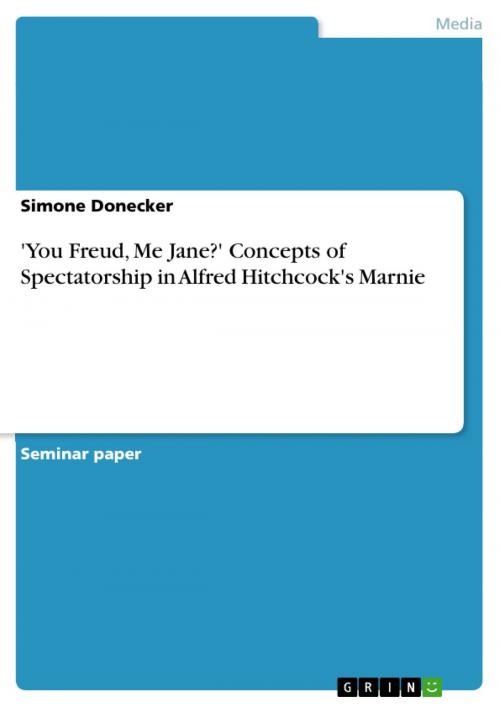'You Freud, Me Jane?' Concepts of Spectatorship in Alfred Hitchcock's Marnie
Nonfiction, Entertainment, Performing Arts, Film| Author: | Simone Donecker | ISBN: | 9783638548083 |
| Publisher: | GRIN Publishing | Publication: | September 24, 2006 |
| Imprint: | GRIN Publishing | Language: | English |
| Author: | Simone Donecker |
| ISBN: | 9783638548083 |
| Publisher: | GRIN Publishing |
| Publication: | September 24, 2006 |
| Imprint: | GRIN Publishing |
| Language: | English |
Seminar paper from the year 2005 in the subject Film Science, grade: A, Indiana University (Department: Communication and Culture), course: Introduction to Media Theory and Aesthetics, language: English, abstract: Men act and women appear. Men look at women. Women watch themselves being looked at. In the history of cinema Hitchcock appears as one who no longer conceives of the constitution of a film as a function of two termsthe director and the film to be made - but as a function of three: the director, the film and the public which must come into the film, or whose reactions must form an integrating part of the film. The interest of visual narrative in Alfred Hitchcock's movies is well-documented and widely-known. His films provide a context for the analyses of spectatorship which examine the theories, structures, and functions of the gaze. Furthermore, by letting the spectator negotiating and producing the film's meaning, Hitchcock's works acknowledge the presence of the audience. His film's calculated narrative style, the self-consciousness within his works, and the address of the spectator make his movies a prolific source for the examination of different approaches to the media viewer. In film theory, Hitchcock's concentration on the male character and the male gaze represents a specific and often problematic debate. In my paper I will examine some of the theories that shaped the discourse of identifying and positioning the spectator within the narrative of film by focusing on Alfred Hitchcock's filmMarnie(1964), since this movie is probably Hitchcock's most significant work to visualize the subjective psychological states of his problematic central character through the use of cinematic technique. First, I want to focus on a psychoanalytical interpretation by explaining the dynamics that Laura Mulvey describes in her analysis of conventional narrative films in the 'classical' Hollywood tradition that not only typically focus on a male protagonist in the narrative, but that also assume a male spectator. Theories that work within this tradition have cited Hitchcock as a director exemplary of the Freudian or Lacanian exegesis. By the 1980s Mulvey's theory generated considerable controversy amongst film theorists and was criticized to present an oversimplification of Hitchcock's agenda. Since then scholars shifted their interest to a strong empiric or historic focus on the spectator. The collapse of the psychoanalytic interpretation was replaced by heavily contextualized analyses that questioned universalizing categories. [...]
Seminar paper from the year 2005 in the subject Film Science, grade: A, Indiana University (Department: Communication and Culture), course: Introduction to Media Theory and Aesthetics, language: English, abstract: Men act and women appear. Men look at women. Women watch themselves being looked at. In the history of cinema Hitchcock appears as one who no longer conceives of the constitution of a film as a function of two termsthe director and the film to be made - but as a function of three: the director, the film and the public which must come into the film, or whose reactions must form an integrating part of the film. The interest of visual narrative in Alfred Hitchcock's movies is well-documented and widely-known. His films provide a context for the analyses of spectatorship which examine the theories, structures, and functions of the gaze. Furthermore, by letting the spectator negotiating and producing the film's meaning, Hitchcock's works acknowledge the presence of the audience. His film's calculated narrative style, the self-consciousness within his works, and the address of the spectator make his movies a prolific source for the examination of different approaches to the media viewer. In film theory, Hitchcock's concentration on the male character and the male gaze represents a specific and often problematic debate. In my paper I will examine some of the theories that shaped the discourse of identifying and positioning the spectator within the narrative of film by focusing on Alfred Hitchcock's filmMarnie(1964), since this movie is probably Hitchcock's most significant work to visualize the subjective psychological states of his problematic central character through the use of cinematic technique. First, I want to focus on a psychoanalytical interpretation by explaining the dynamics that Laura Mulvey describes in her analysis of conventional narrative films in the 'classical' Hollywood tradition that not only typically focus on a male protagonist in the narrative, but that also assume a male spectator. Theories that work within this tradition have cited Hitchcock as a director exemplary of the Freudian or Lacanian exegesis. By the 1980s Mulvey's theory generated considerable controversy amongst film theorists and was criticized to present an oversimplification of Hitchcock's agenda. Since then scholars shifted their interest to a strong empiric or historic focus on the spectator. The collapse of the psychoanalytic interpretation was replaced by heavily contextualized analyses that questioned universalizing categories. [...]















